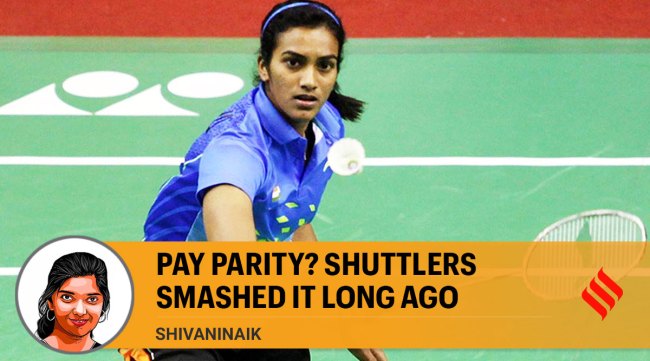Opinion Pay parity? Shuttlers smashed it long ago
For years now, the end-of-season prize-money lists published by Badzine, the diligent recorder of all developments in shuttle, has had a pinned entry of one or the other woman Chinese doubles shuttlers who top tournament earnings each year.
 Shivani Naik writes: Badminton has always known pay parity, given the prize kitty gets equally split. In pic, badminton champion P V Sindhu (File Photo)
Shivani Naik writes: Badminton has always known pay parity, given the prize kitty gets equally split. In pic, badminton champion P V Sindhu (File Photo) For want of a better word, my conditioning in sport owing to my predominant journalism beat focus on badminton comes with a severely ‘matriarchal’ lens.
For years now, the end-of-season prize-money lists published by Badzine, the diligent recorder of all developments in shuttle, has had a pinned entry of one or the other woman Chinese doubles shuttlers who top tournament earnings each year. This is by virtue of dominating women’s doubles, while attaining formidable results in mixed doubles, too, on the circuit.
Women top badminton earnings ahead of men, like an everyday fact of life: Sun rises; water is wet; women earn more.
Badminton has always known pay parity, given the prize kitty gets equally split over men’s singles, women’s singles, men’s doubles, women’s doubles and mixed doubles, who all play three sets. Forgive me for then expecting pay parity to be almost basic and axiomatic in any reasonably evolved sport.
The last decade, dubbed the golden generation of women’s singles — of which P V Sindhu and Saina Nehwal were a part and where Chinese domination was cut down by shuttlers from across the world, where crowds thronged stadiums to watch Tai Tzu Ying, Ratchanok Intanon, Carolina Marin, Nozomi Okuhara, Chen Yufei, Akane Yamaguchi and An Se Young play — further accentuated the belief in true parity of women’s sport.
Tournament Sundays were routinely headlined by women’s singles finals as the climax, with the men often playing on undercards, especially after the exit of Lee Chong Wei and Lin Dan. It was an obvious and unfussed call, taken on the basis of which final would crescendo spectator interest. People came and stayed to watch the generation’s finest women’s singles talent challenge each other to cap an evening at the arena.
It is against this backdrop of subtle acknowledgement that Indian cricket’s latest announcement of equal match fees for women — same as the top male internationals — carries a whiff of a sport simply catching up with evolved times.
It’s why tennis and cricket and their long struggle for something so fundamental always befuddles someone accustomed to watching badminton, which didn’t announce its egalitarian cred in paying women as much as it paid men. The sport just halved the prize money fraction, and disbursed the funds as a matter of routine.
But the world outside badminton is different.
Serena Williams’ struggle to demand a Centre Court face-off stage was real. Grand Slams had to be pushed and shamed into bringing parity to match winnings. Cricket, a late starter for women despite hosting the first Women’s World Cup in 1973 (men only hosted theirs in 1975), has needed the T20 rub-off and some blunt telling-offs of its crusty ways, to come up to speed on the issue of even broaching pay parity. Throughout the pandemic, the women barely played any cricket, while mountains were moved to ensure men got their T20 gig.
The BCCI has woken up — ahead of England and Australia, it must be said — to come up with their slightly muddled version of ‘pay parity’. The basic retainership of a Rohit Sharma would be Rs 7 crore, while Harmanpreet Kaur gets Rs 50 lakh as base, and then the newly introduced ‘equal match fees’, though she will play considerably fewer matches, and take home a commensurately lesser pay packet.
It’s why ‘pay parity’ — while admirable in intent and a good start — cannot be the goal pursued by women’s sport, though even getting there seems ambitious. The USA women’s soccer teams have won four FIFA World Cups — their men have won none — but have to be cited as an example, and even be grateful, for earning as much as the men.
A Tai Tzu Ying in women’s badminton is a considerably bigger draw in badminton than a Chou Tien Chen in men’s, yet shuttle must stay content in its head-start on pay-parity, while not raising the issue of pay-paucity and its low base of potential earnings, for either sexes.
The Commonwealth Games women’s T20 final between India and Australia was a full-house at Edgbaston — paid tickets, thriller till penultimate over and all — and yet, Harmanpreet and Smriti Mandhana must bide their time and hope the Women’s IPL takes off, before they are seen by their home board as an exciting game of cricket to watch for the family.
The broad contours of pay parity do not accommodate the badminton possibility — that some day, the women’s game might prove even more watchable than the men’s competition (as the last decade of shuttle evidenced).
Any gymnastics venue will pay good gate money to watch Simone Biles execute her aeronautic skillset, and her return remains much anticipated in the sport. The women’s Euro final brought England to a standstill — and also got them the Cup, something their carping, whingeing men’s team hasn’t managed to nail down in many years.
Families with young, pigtailed school girls shyly face-painting the tricolour, drove down from London, Manchester and Edinburgh to watch the Indian women play the CWG finals at Birmingham.
Jamaican sprinter Elaine Thompson-Herah got the Alexander Stadium on its feet and they queued up since noon to watch her have a go at her 100m — golden hair flowing and all. Those who watch sports don’t go in wearing a comparison lens.
USA’s Women’s NBA (WNBA) has pushed average salaries upward of the USD 200,000 mark. And what Indian cricket did this week was basic: a start, from where slightly bright marketing whizzes and cricket’s awakened administration can only build up a property that has remarkable potential in the T20 format to mint millions, exactly like the men’s game did. Turning women’s cricket into a money spinner for the board is a matter of when, not if. There’s revenue potential there, even if you don’t like the word ‘revolution’. Watch Harmanpreet tonk sixes LIVE just once, and you’d know.
Mix Martial Arts legend Ronda Rousey had once said: “I’m the highest-paid fighter not because (promoters) Dana and Lorenzo wanted to do something nice for the ladies. They do it because I bring in the highest numbers. Because I make them the most money.” Textbook pay parity would do no justice to the great Ronda who knows respect and appreciation must equal money. It’s not a favour.
Women’s sport should not have to struggle for achieving pay parity. Or what passes off as the well-worded press release on pay parity. If you’ve watched female badminton players fill stadiums all these years, you’d know women’s sport, in a world craving inspirational role models, has been a marketeer’s miss. Pay parity doesn’t even begin to describe blazing ambition.





